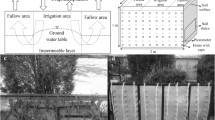Abstract
Dry drainage is thought to be a potential approach to control soil salinity. This study took the Hetao Irrigation District as an example and evaluated the effectiveness of dry drainage by using remote sensing, a conceptual model and a field experiment. Archived remote sensing images from 1973–2006 were used to delineate the temporal and spatial change of soil salinity. The conceptual water and salt balance model was used to evaluate the role of dry drainage in removing excess salt from the irrigated land. The field experiment was performed to get field validation and give more accurate estimation. The results show that dry drainage did contribute to remove excess salt from the irrigated land and succeed in controlling soil salinity in the Hetao Irrigation District. It can be taken as an alternative approach in (semi-)arid area where artificial drainage is not applicable.
Similar content being viewed by others
References
Konukcu F, Gowing J W, Rose D A. Dry drainage: A sustainable solution to waterlogging and salinity problems in irrigation areas? Agr Water Manage, 2006, 83(1–2): 1–12
Wichelns D, Oster J D. Sustainable irrigation is necessary and achievable, but direct costs and environmental impacts can be substantial. Agr Water Manage, 2006, 86(1–2): 114–127
Department of Primary Industries, Parks, Water and Environment of Australia. Environmental Best Practice Guidelines: Minimising Environmental Harm from Agricultural Drainage Channels. Tasmania: DPIWE, 2003. 1–3
Leslie A Z, Larry C B. Agricultural Drainage: Water Quality Impacts and Subsurface Drainage Studies in the Midwest. Ohio: Ohi State University Extension Bulletin, 1998. 871–898
Edwin D O. FAO Irrigation and Drainage Report Paper 55: Control of Water Pollution from Agriculture. Rome: FAO, 1996. 1–13
Dougherty T C, Hall A W. FAO Irrigation and Drainage Paper 53: Environmental Impact Assessment of Irrigation and Drainage Projects. Rome: FAO, 1995. 43–45
Khouri N. Potential of dry drainage for controlling soil salinity. Can J Civil Eng, 1998, 25(2): 195–205
Gowing J W, Wyseure G C L. Dry-drainage, a sustainable and cost-effectible solution to water logging and salinization. Proceedings of 5th International Drainage workshop. Lahore Pakistan: ICID-CIID, 1992. 6.26–6.34
Khouri N. A study of the potential of dry drainage for contorlling soil salinity in Department of Civil Engineering. Dissertation of Doctoral Degree. Unite Kingdom: The University of Newcastle upon Tyne, 1994
West Africa Rice Development Association. WARDA Annual Report, 1997. 36–44
Kovda V A. Origin of Saline Soils and Their Regime. Jerusalem: Israel Program for Scientific Translations, 1971. 168–172
Lei Z D, Shang S H, Yang S X, et al. Preliminary analysis on the dry drainage effect of low-lying lands in Yerqiang Oasis in Xinjiang. J Irrig Drain, 1998, 17(3): 1–4
Globus A M. Physics of Non-isothermal Soil Moisture Transfer. Leninggrad: Hydrometeoizdat Publisher, 1983. 252
Shimojima E, Yoshioka R, Tamagawa I. Salinization owing to evaporation from bare-soil surfaces and its influences on the evaporation. J Hydrol, 1996, 178(1–4): 109–136
Nassar I N, Horton R. Salinity and compaction effects on soil water evaporation and water and solute distributions. Soil Sci Soc Am J, 1999, 63(4): 752–758
Van Hoorn J W, Van Alphen J G. Salinity control. In: Ritzema H P, ed. Drainage Principles and Applications, Chapter 15. Wageningen: International Institute for Land Reclamation and Improvement, 1994. 533–600
Metternicht G I, Zinck J A. Remote sensing of soil salinity: potentials and constraints. Remote Sens Environ, 2003, 85(1): 1–20
Inner Mongolia Hydrogeological Survey Team. The Hydrogeological Condition and the Approach of Salinity Control in Hetao Irrigation District (in Chinese). Huhhot: Inner Mongolia Hydrogeological Survey Team, 1982. 10–11
Leica Geosystems. ERDAS Field Guide. Norcross: Leica Geosystems Geospatial Imaging, LLC, 2005. 656
Allen R G, Pereria L S, Rame D, et al. FAO Irrigation and Drainage Paper 56: Crop Evapotranspiration (Guidelines for Computing Crop Water Requirements). Rome: FAO, 1998. 326
Wang L P, Chen Y X, Zeng G F. Irrigation, Drainage and Salinity Control in Hetao Irrigation District, Inner Mongolia (in Chinese). Beijing: China Waterpower Press, 1993. 52–53
Author information
Authors and Affiliations
Corresponding author
Additional information
Supported by the National Natural Science Foundation of China (Grant No. 50809050), the National Basic Research Program of China (“973” Project) (Grant No.2006CB403406), and the National Key Technology R&D Program (Grant No. 2006BAD11B06)
Rights and permissions
About this article
Cite this article
Wu, J., Zhao, L., Huang, J. et al. On the effectiveness of dry drainage in soil salinity control. Sci. China Ser. E-Technol. Sci. 52, 3328–3334 (2009). https://doi.org/10.1007/s11431-009-0341-8
Received:
Accepted:
Published:
Issue Date:
DOI: https://doi.org/10.1007/s11431-009-0341-8




